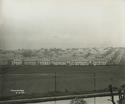 Knightswood originally lay in the Dunbartonshire parish of New or East Kilpatrick. The name alludes to the medieval Knights Templar who reputedly occupied the site as far back as the 12th century. Their presence is also suggested in the name of the nearby Temple district. By 1910, as the writer T C F Brotchie (1878-1937) observed, Knightswood was a beauty spot located to the south-west of the Forth & Clyde Canal, made up of farmland and disused mining works. The most prominent sign of encroaching urbanisation was Knightswood Fever Hospital, erected jointly in the 1870s by the Police Burghs of Partick, Hillhead and Maryhill. By 1912 the burghs had all been incorporated into the city and Glasgow Corporation administered the Hospital.
Knightswood originally lay in the Dunbartonshire parish of New or East Kilpatrick. The name alludes to the medieval Knights Templar who reputedly occupied the site as far back as the 12th century. Their presence is also suggested in the name of the nearby Temple district. By 1910, as the writer T C F Brotchie (1878-1937) observed, Knightswood was a beauty spot located to the south-west of the Forth & Clyde Canal, made up of farmland and disused mining works. The most prominent sign of encroaching urbanisation was Knightswood Fever Hospital, erected jointly in the 1870s by the Police Burghs of Partick, Hillhead and Maryhill. By 1912 the burghs had all been incorporated into the city and Glasgow Corporation administered the Hospital.
 In 1921 the Corporation purchased the lands of Knightswood from the Summerlee Iron Company with the prime objective of building new homes. Since 1919 central government had provided state subsidies for municipal housing and "schemes" in Glasgow, notably Mosspark and Riddrie, were already showpieces of modern planning. Knightswood was built in a similar style to Mosspark with low density "cottage" style dwellings and four-in-a-block apartments. Under the provisions of 1920s housing legislation over 6,000 homes were constructed making Knightswood the largest of the Corporation's inter-war estates. Ironically, much of the area initially lay outside the city boundaries, which created problems of administrative and financial control. To co-ordinate Knightswood's development, the district was wholly absorbed into Glasgow in 1926.
In 1921 the Corporation purchased the lands of Knightswood from the Summerlee Iron Company with the prime objective of building new homes. Since 1919 central government had provided state subsidies for municipal housing and "schemes" in Glasgow, notably Mosspark and Riddrie, were already showpieces of modern planning. Knightswood was built in a similar style to Mosspark with low density "cottage" style dwellings and four-in-a-block apartments. Under the provisions of 1920s housing legislation over 6,000 homes were constructed making Knightswood the largest of the Corporation's inter-war estates. Ironically, much of the area initially lay outside the city boundaries, which created problems of administrative and financial control. To co-ordinate Knightswood's development, the district was wholly absorbed into Glasgow in 1926.
 There was some concern to establish amenities in Knightswood; for instance, a 69-hectare public park was laid out during the 1920s. Although the scale of building meant that some of the post-1926 houses did not conform to the same high standards of earlier properties, the scheme still remained one of the most desirable in Glasgow. The fictional McFlannel family, whose soap opera exploits enthralled Scottish radio listeners during the 1940s, moved decidedly "up in the world" (according to the author) when they flitted from a Partick tenement to a four-apartment in Knightswood. However, the family's subsequent complaints about remoteness from the city, especially the time spent travelling to work, was a realistic reflection of the downside of the Corporation building programme.
There was some concern to establish amenities in Knightswood; for instance, a 69-hectare public park was laid out during the 1920s. Although the scale of building meant that some of the post-1926 houses did not conform to the same high standards of earlier properties, the scheme still remained one of the most desirable in Glasgow. The fictional McFlannel family, whose soap opera exploits enthralled Scottish radio listeners during the 1940s, moved decidedly "up in the world" (according to the author) when they flitted from a Partick tenement to a four-apartment in Knightswood. However, the family's subsequent complaints about remoteness from the city, especially the time spent travelling to work, was a realistic reflection of the downside of the Corporation building programme.